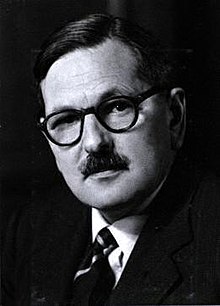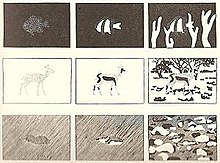Hugh B. Cott
Hugh B. Cott | |
|---|---|
 Hugh Bamford Cott, probably in 1945 when he became a fellow of Selwyn College.
Courtesy of Anura (1938) | |
| Doctoral advisor | John Graham Kerr |
Hugh Bamford Cott (6 July 1900 – 18 April 1987) was a British
Life and career
Cott was born in
He had intended to become a priest, and went to Cambridge to read theology, but after his first year he went on the university expedition to
Cott served in the Leicestershire Regiment of the
After the war, Cott returned to Cambridge, becoming a Fellow of Selwyn College in 1945; he worked there until he retired in 1967.
Camouflage

While trying to photograph a hen partridge on her nest, Cott waited for hours for the bird to return, finally taking some pictures of the empty nest before giving up. On developing the photographs, he realized the bird had been there all along, perfectly camouflaged.[15]
As a
- merging, e.g. hare, polar bear[16]
- disruption, e.g. ringed plover[16]
- disguise, e.g. stick insect[16]
- mis-direction, e.g. butterfly and fish eyespots[16]
- dazzle, e.g. some grasshoppers[16]
- decoy, e.g. angler fish[16]
- smokescreen, e.g. cuttlefish[16]
- the dummy, e.g. flies, ants[16]
- false display of strength, e.g. toads, lizards[16]

Cott's account of all this (illustrated by his own pen and ink drawings) is the 550-page book Adaptive Coloration in Animals (1940).[18] It was proof-read by Kerr, who commented on its publication 'It is by far the finest thing of the kind in existence'.[19] His co-workers' first-hand accounts of his work in military camouflage can be found in the memoirs of two of his fellow camoufleurs: Julian Trevelyan[20] and Roland Penrose.[21]
Peter Forbes wrote of Cott's book:[22]
Cott's Adaptive Coloration in Animals must be the only compendious zoology tract ever to be packed in a soldier's kitbag. The book also marks the apotheosis of the descriptive natural history phase of mimicry studies. Although Cott does report experiments on predation to test the efficacy of mimicry and camouflage, the book is essentially a narrative of examples plus theory.[22]

The book was written as war loomed, and published in wartime. Cott makes use of his knowledge of natural history to draw parallels between survival in nature and in war,[24] and to advise on military camouflage, for example commenting:
Various recent attempts to camouflage tanks, armoured cars, and the roofs of buildings with paint reveal an almost complete failure by those responsible to grasp the essential factor in the disguise of surface continuity and contour … in nature vigorous disruptive contrasts are frequently seen at work, and their wonderful effectiveness in hindering recognition needs to be experienced in the field to be fully appreciated.[23]
Forbes notes that Adaptive Coloration in Animals is a narrative, short on the experimentation that followed after the war, but Forbes continues:[22]
But Cott's book is still valuable today for its enormous range, for its passionate exposition of the theories of mimicry and camouflage.[22]
Cott attempted to persuade the British army to use more effective camouflage techniques, including countershading. For example, in August 1940, with the
These photographs furnish most convincing proof of the effectiveness of countershading, and are especially valuable in that we have in them a direct comparison between the two methods.
However (like Kerr before him in the First World War), Cott did not succeed in influencing policy on camouflage, and he resigned from the Camouflage Advisory Panel in 1940.[25]
Artwork

Cott was a founding member of the Society of Wildlife Artists, and a fellow of the Royal Photographic Society.[5] From material gathered in field expeditions, he made contributions to the Cambridge University zoological museum.
Cott possessed considerable artistic skill. Like
Back to Hugh Cott's marvelous engraving of a potoo hidden in a black and white Costa Rican forest, frozen vertically like the tree trunk on which it hides. In nature the visible and invisible dance back and forth with each other, depending on how much we have learned to see. The science and art of this magic merge into one at the moment we grasp it.[26]
Writings
In addition to Adaptive Coloration in Animals, Cott wrote two essays on camouflage: “Camouflage in nature and in war”[27] and ”Animal form in relation to appearance”.[28] As a scientific illustrator and photographer, he also wrote three other books: Zoological photography in practice (1956); Uganda in black and white (1959); and Looking at animals: a zoologist in Africa (1975). He became interested in the relationship of bird colours with their role as warning colours, an idea that arose when he observed hornets attracted to some birds being skinned while ignoring others. This led him to study the palatability of birds and their eggs. Among his papers were several studies on the relative palatibility of the eggs based initially on the preferences of ferrets, rats and hedgehogs and later on the use of a panel of expert egg tasters. In one study he found that of 123 species of bird, the kittiwake eggs scored highly with 8.2 out of 10.[29][30][31][32]
Legacy
Forbes praised Cott's balance of science and artistry:[22]
..in the conflict between artists and biologists, he was both. Cott was a competent illustrator as well as a biologist. Without having
Nabokov's precisianism and anti-Darwinism, he brought an artistic sensibility to bear on these phenomena. His text is radiant with the wonder of these adaptations.[22]
Over 60 years after its publication, Adaptive Coloration in Animals remains a core reference on the subject; the evolutionary biologists Graeme Ruxton, Thomas N. Sherratt and Michael Speed conclude their book on animal coloration by writing
The study of animal coloration and associated anti-predator adaptations has a long history... this field of research has been blessed from the earliest years with the insights of particularly gifted scientists. The writings of Wallace, Bates, Müller, Poulton and Cott truly stand up to the test of time: these individuals deserve even better renown not just as great natural historians but as exceptional scientists too.[33]
The biologist Steven Vogel commented that:[34]
The zoologist Hugh Cott had the final word in Adaptive Coloration in Animals (1940), a definitive synthesis of everything known about
Biomimeticcamouflage took its place as yet another technique in a sophisticated armamentarium of visual deceptions.
An exhibition of his art, writing, and photographs, 'Life, Lines & Illusion', was held at the Nature in Art gallery in Gloucester in September and October 2018.[35]
References
- ^ Forsyth 2012, p. 67.
- ^ a b "Papers of Hugh Cott". SEPP/COT (formerly HC/1-2). Janus. Retrieved 25 July 2012.
- ^ Forsyth 2012, p. 127.
- .
- ^ a b c d "Hugh Bamford Cott". University of Glasgow. Retrieved 17 October 2012.
- ISBN 978-1408138397.
- ^ Forsyth 2014.
- ^ London Gazette 26 January 1920. Cott is in the Leicestershire Regiment.
- London Gazette. 28 January 1941. p. 552.
- ^ Forbes 2009, pp. 155–156.
- ^ Forsyth 2012, p. 124.
- ^ "Fison Memorial Lectures" (PDF). King's College London. Archived from the original (PDF) on 6 January 2014. Retrieved 5 January 2014.
- .
- ^ Pooley, Tony (April 1972). "Newsletter No. 4" (PDF). IUCN Crocodile Specialists Group. Retrieved 15 January 2014.
- ^ Forsyth 2012, pp. 122–123.
- ^ a b c d e f g h i j Forbes 2009, pp. 152–153. Farnham Lecture No. 5
- ^ a b c Forbes 2009, pp. 149–150
- ^ Cott 1940.
- ^ Forsyth 2012, p. 140.
- ^ Trevelyan 1957.
- ^ Penrose 1981.
- ^ a b c d e f g Forbes 2009, p. 153
- ^ a b Cott 1940, pp. 53–54 Cited in Forsyth 2012, p. 149
- ^ Forsyth 2012, pp. 147–148.
- ^ Forsyth 2012, p. 173.
- ^ a b c Rothenberg, David (2011). Survival of the Beautiful: Art, Science and Evolution. Bloomsbury. p. 167.
- ^ in the Royal Engineers Journal (December 1938), pp. 501–517
- ^ in Lancelot Law Whyte, ed. Aspects of form: a symposium on form in nature and art (London: Percy Lund Humphries, 1951)
- ^ Prchlik, Maria (25 November 2013). "Don't try this at home". Royal Society for the Protection of Birds. Retrieved 5 January 2014.
- .
- .
- .
- ^ Ruxton, Sherratt & Speed 2004, p. 200.
- ^ "Life, Lines & Illusion". Nature In Art. Retrieved 12 October 2018.
Bibliography
By Cott
- Books
- Cott, Hugh B. (1940). Adaptive Coloration in Animals. Methuen.
- Cott, Hugh B. (1975). Looking at Animals: a Zoologist in Africa. Scribner.
- Cott, Hugh B. (1959). Uganda in Black and White. Macmillan.
- Cott, Hugh B. (1956). Zoological Photography in Practice. Fountain Press.
- Journals
- Cott, Hugh B. (1936). "The effectiveness of protective adaptations in the Hive-Bee, illustrated by experiments on the feeding reactions, habit formation, and memory of the common toad (Bufo bufo bufo)". Proceedings of the Zoological Society of London. 106 (1): 111–133. .
- Cott, Hugh B. (1951). "The Palatability of the Eggs of Birds: Illustrated by Experiments on the Food Preferences of the Hedgehog (Erinaceus Europaeus)". Proceedings of the Zoological Society of London. 121 (1): 1–41. .
- Cott, Hugh B. (1952). "The palatability of the eggs of birds: illustrated by three seasons' experiments (1947, 1948 and 1950) on the food preferences of the Rat (Rattus norvegicus); and with special reference to the protective adaptations of eggs considered in relation to vulnerability". Proceedings of the Zoological Society of London. 122 (1): 1–54. .
- Cott, Hugh B. (1953). "The palatability of the eggs of birds: illustrated by experiments on the food preferences of the Ferret (Putorius furo) and Cat (Felis catus); with notes on other egg-eating Carnivora". Proceedings of the Zoological Society of London. 123 (1): 123–141. .
- Cott, Hugh B. (1938). Wonder Island of the Amazon Delta; on Marajo Cowboys Ride Oxen, Tree-Dwelling Animals Throng Dense Forests. National GeographicMagazine.
About Cott
- Forbes, Peter (2009). Dazzled and Deceived: Mimicry and Camouflage. Yale. ISBN 978-0-300-12539-9.
- Forsyth, Isla McLean (2012). From dazzle to the desert: a cultural-historical geography of camouflage (PhD). University of Glasgow (PhD thesis).
- Forsyth, Isla (2014). "The practice and poetics of fieldwork: Hugh Cott and the study of camouflage" (PDF). Journal of Historical Geography. 43: 128–137. .
- Penrose, Roland (1981). Scrapbook 1900–1981. Thames and Hudson.
- ISBN 0-19-852860-4.
- Trevelyan, Julian (1957). Indigo days. MacGibbon and Kee.


